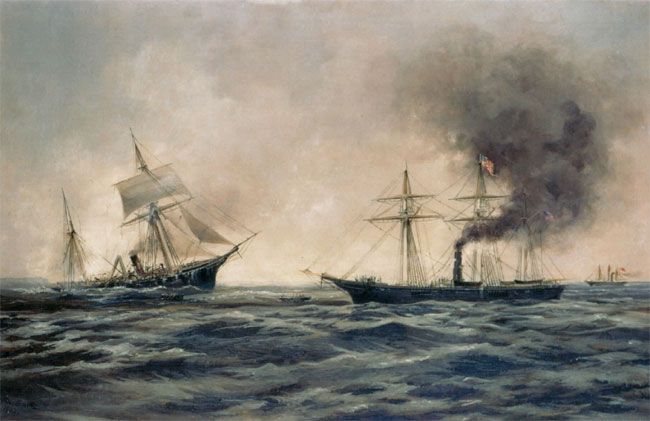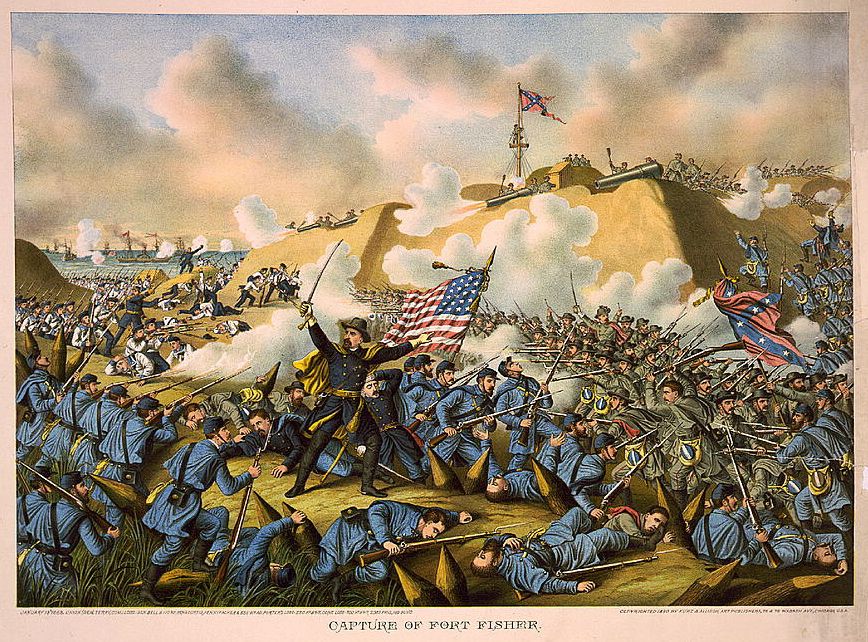American Civil War (1861-1865)
The naval battles of the American Civil War, fought between the Union and the Confederacy, changed the foundation of naval warfare with the first use of ironclads and submarines, and the introduction newer and more powerful naval artillery. The first shots of the naval war were fired on April 13, 1861 during the Battle of Fort Sumter by the US Revenue Cutter Service cutter USRC Harriet Lane. The final shots were fired on June 22, 1865 by the Confederate raider CSS Shenandoah in the Bring Strait, more than two months after General Robert E. Lee's surrender of the Confederate Army.
The significant Battles of the war were:
Hampton Roads; fought between the USS Monitor and the CSS Virginia at Hampton Roads, Virginia. The battle, on March 8, 1862, lasted several hours resulting in a tactical draw. The new warships were protected by the thick armor plating that gives them the name ironclad, which prevented any lasting damage. This was the first battle involving two ironclads.
New Orleans; the battle of Forts Jackson and St. Philip in 1862 can be divided into two parts, a mostly ineffective bombardment of the Confederate held forts by the raft-mounted mortars, and the successful passage of the forts by much of Farragut's fleet on the night of April 14. During the passage, one Federal warship was lost and three others turned back while the Confederate gunboats were virtually obliterated. The subsequent capture of the city, achieved with no further significant opposition, was a serious blow from which the Confederacy never recovered.
First Charleston; a second great naval battle occurred at Charleston, South Carolina, in 1863. In this battle, called the First Battle of Charleston Harbor, the Union Navy sent Admiral DuPont with nine ironclads to attack Charleston. He did not expect to be victorious. He would have to steer his ships upriver to the fort and attack it from a standstill, giving the Confederates a valuable edge. The Union Navy was forced to retreat within two hours to prevent too many casualties in a single battle, which would irreparably cripple the navy. Because of this failure, the Union would blockade Charleston for two more years, while the Confederacy was able to set up several more forts along the coast of Sough Carolina.
Cherbourg; the Battle of Cherborg was an intense naval battle that ended in the sinking of CSS Alabama, one of the most powerful ships in the Confederate fleet, by USS Kearsage. Alabama fired the first shot, but Kearsage was slightly faster, had more firepower and was manned by a larger crew than Alabama, giving the Union teh advantage. The Confederate ship took many hits and casualties, and the rising water shut off its engines, leaving the surviving crew with no other choice but to surrender and be rescued by Kearsage.

Both navies engaged in over 70 battles. The first use of torpedoes was at the Battle of Aquia Creek by the Confederate Navy. The CSS David was the first torpedo boat to make a successful attack on an enemy warship (USS New Ironsides). The largest amphibious assault of the war was the Second Battle of Fort Fisher, North Carolina.

The navies on both sides not only engaged in over 70 battles, but also transported foot soldiers, equipment and supplies. Without a navy, neither army would have had the supplies or manpower necessary to successfully carry out the war. Thus, one major strategy of the Union navy involved blockading Southern ports, preventing the South from receiving supplies or aid from allies via shipping ports. Vital supplies such as food, water, ammunition, guns, clothes and medical supplies never made it to the Confederate troops. The Confederates retained a sufficient amount of resources to withstand the blockade for an extended period of time, causing the war to last longer than expected. However, the blockade continued to prevent the Confederate troops from replenishing their supplies, which in part led to their eventual defeat.
Naval ships on both sides also served as much needed floating hospitals, housing and treating soldiers who had been injured.
